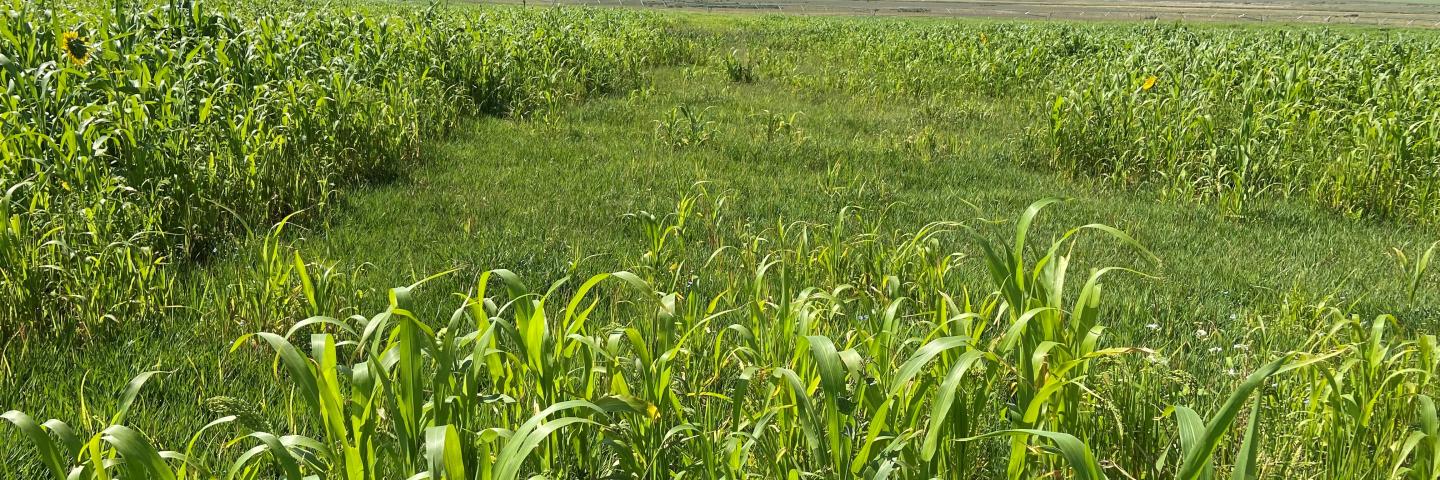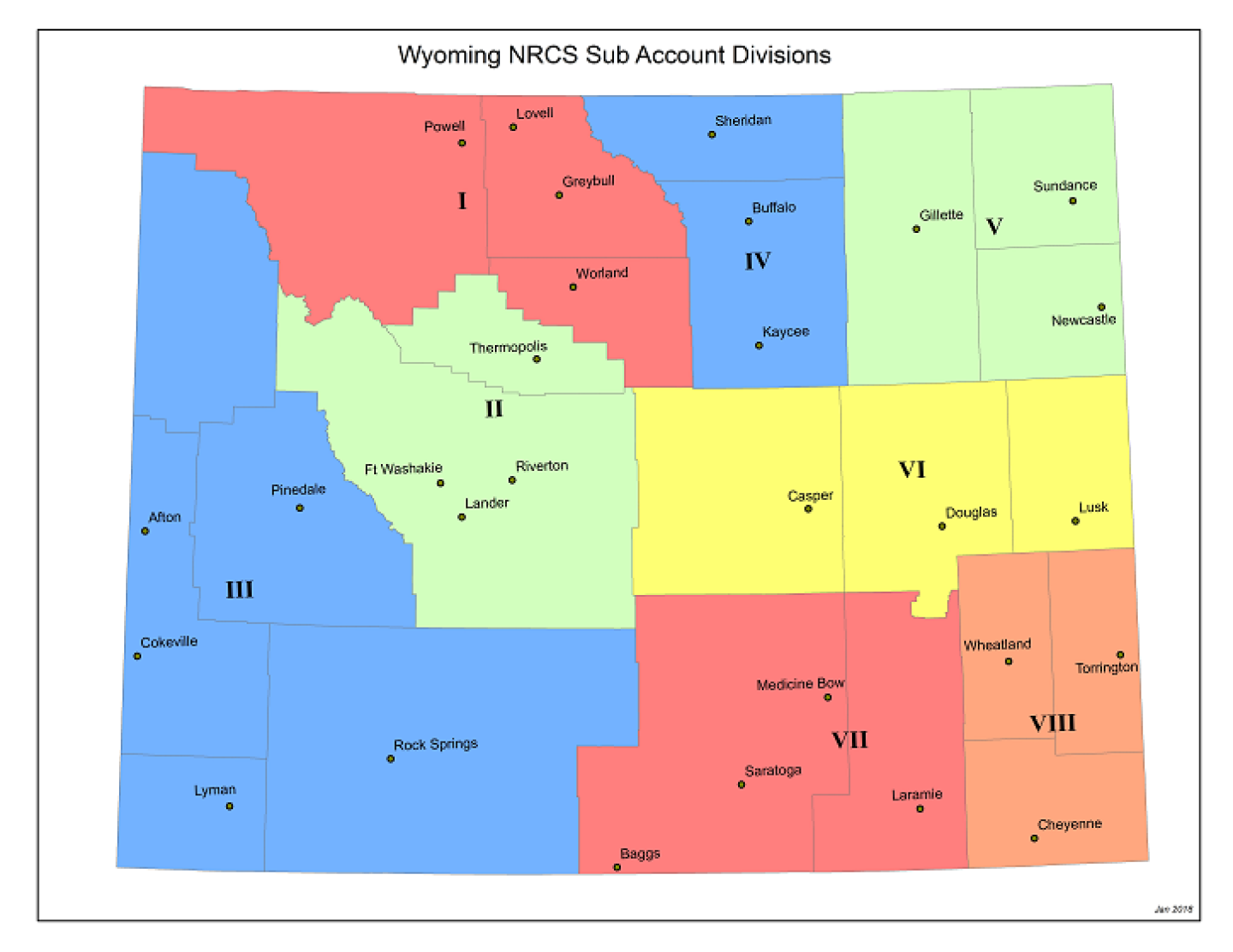
The Environmental Quality Incentives Program (EQIP) is a voluntary conservation program that helps agricultural producers in a manner that promotes agricultural production and environmental quality as compatible goals.
Wyoming EQIP Funding Pools and Ranking Document
In 2014, Wyoming Natural Resources Conservation Service (NRCS) created eight divisions within the state for developing ranking criteria to treat irrigation and grazing land resource concerns. Similar resource concerns, land use, climate, topography and farming and ranching practices were considered when developing these divisions. Four subaccounts were developed for each division based on land use and resource concern. The subaccounts and ranking tools are the same for all eight divisions.

State Priorities
Wyoming has identified the following priorities, based on recommendations from the Wyoming State Technical Committee. The State Technical Committee is made up of representatives from various producer groups, conservation organizations, agribusinesses, and federal, state, and tribal government agencies.:
Allocation Criteria/Demographic Factors
- Number of farms/ranches
- Number of Historically Underserved Producers
Resource Factors
- Private, Tribal, and other non-federal acres needing treatment
- Irrigated acres
- Federal acres
- Riparian/wetland acres
- At-risk species habitat
Management Factors
- Measured performance
Additional tools needed to answer Irrigation sub-account questions:
- FIRI 1.5
- Gully-Ephemeral-Streambank-Irrig-Ditch-Erosion
- WY 2012 Water Quality Assessment and Impaired Waters List 305 (b) and 303 (d) Report
Eligible Conservation Practices:
The Wyoming electronic Field Office Tech Guide (eFOTG)contains a list of potential practices eligible for financial assistance.
Wyoming Practice Payment Rates and Caps for Conservation Practices
Accomplishments
Since 1997, over $130 million of EQIP financial assistance has been distributed across Wyoming to address natural resource concerns. These dollars will allow private landowners to implement prescribed grazing and other land treatments on rangeland; install improved irrigation and water management systems on cropland and hayland; address water quality concerns, including livestock waste management; and improve riparian area health and wildlife habitat.
Additional Information
Apply for Environmental Quality Incentives Program (EQIP)
The Environmental Quality Incentives Program (EQIP) provides financial and technical assistance to agricultural producers and non-industrial forest managers.
Learn MoreHistorically Underserved Farmers and Ranchers
The Agriculture Improvement Act of 2018 (2018 Farm Bill) includes provisions that address the unique circumstances and concerns of socially disadvantaged, beginning, limited resource, and veteran farmers and ranchers (“historically underserved producers”).
Learn MoreFarm Bill
The 2018 Farm Bill was enacted on December 20, 2018. The Farm Bill continues its strong support for conservation efforts of America’s farmers and ranchers through reauthorization and expanded flexibility of NRCS conservation programs.
Learn MoreReady to get started?
Contact your local service center to start your application.
How to Get Assistance
Do you farm or ranch and want to make improvements to the land that you own or lease?
Natural Resources Conservation Service offers technical and financial assistance to help farmers, ranchers and forest landowners.

To get started with NRCS, we recommend you stop by your local NRCS field office. We’ll discuss your vision for your land.
NRCS provides landowners with free technical assistance, or advice, for their land. Common technical assistance includes: resource assessment, practice design and resource monitoring. Your conservation planner will help you determine if financial assistance is right for you.
We’ll walk you through the application process. To get started on applying for financial assistance, we’ll work with you:
- To fill out an AD 1026, which ensures a conservation plan is in place before lands with highly erodible soils are farmed. It also ensures that identified wetland areas are protected.
- To meet other eligibility certifications.
Once complete, we’ll work with you on the application, or CPA 1200.
Applications for most programs are accepted on a continuous basis, but they’re considered for funding in different ranking periods. Be sure to ask your local NRCS district conservationist about the deadline for the ranking period to ensure you turn in your application in time.
As part of the application process, we’ll check to see if you are eligible. To do this, you’ll need to bring:
- An official tax ID (Social Security number or an employer ID)
- A property deed or lease agreement to show you have control of the property; and
- A farm number.
If you don’t have a farm number, you can get one from USDA’s Farm Service Agency. Typically, the local FSA office is located in the same building as the local NRCS office. You only need a farm number if you’re interested in financial assistance.
NRCS will take a look at the applications and rank them according to local resource concerns, the amount of conservation benefits the work will provide and the needs of applicants. View Application Ranking Dates by State.
If you’re selected, you can choose whether to sign the contract for the work to be done.
Once you sign the contract, you’ll be provided standards and specifications for completing the practice or practices, and then you will have a specified amount of time to implement. Once the work is implemented and inspected, you’ll be paid the rate of compensation for the work if it meets NRCS standards and specifications.

